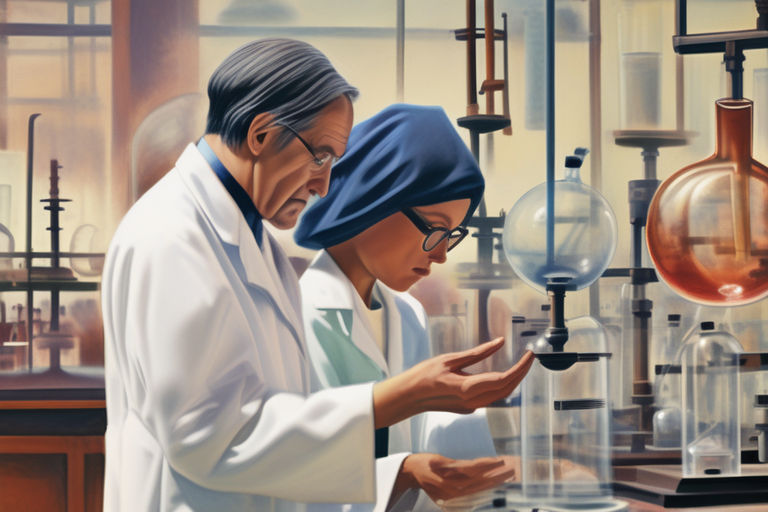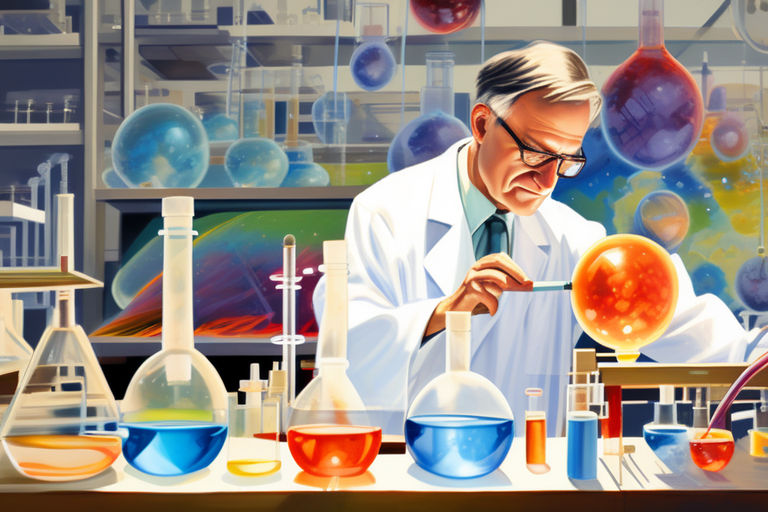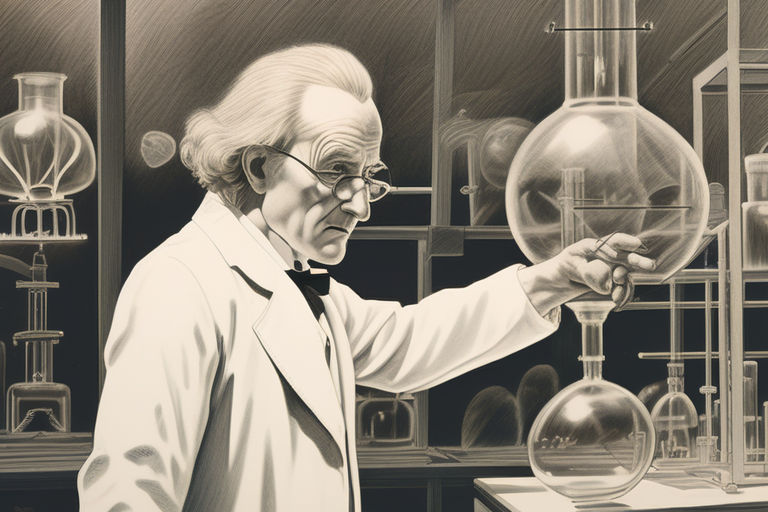What is the Physical Setting in Chemistry and Why Does it Matter?
The physical setting in chemistry refers to the specific conditions, environment, and parameters in which chemical reactions, experiments, and scientific investigations take place. It encompasses the physical surroundings, equipment, and variables that can influence the outcomes of chemical processes. Understanding and controlling the physical setting is crucial in chemistry to ensure the reliability and reproducibility of experimental results.

In the scientific realm, the physical setting plays a pivotal role in shaping the outcomes of experiments. Laboratories are carefully designed and equipped to create a controlled environment where variables can be manipulated and observed systematically. These controlled conditions are essential for conducting reliable and accurate experiments, allowing scientists to draw meaningful conclusions from their observations.
Laboratory conditions involve controlling factors such as temperature, pressure, humidity, and lighting, among others, to create a standardized setting for experiments. This meticulous control helps researchers isolate specific variables and study their effects on chemical reactions. By maintaining a consistent physical setting, scientists can minimize external influences that could introduce errors or uncertainties into their findings.
The physical setting is particularly critical in the context of controlled experiments. In a controlled experiment, researchers manipulate one or more variables while keeping all other conditions constant. This controlled approach allows scientists to attribute observed changes or outcomes to the manipulated variables, providing valuable insights into the fundamental principles of chemistry.
In summary, the physical setting in chemistry encompasses the carefully controlled scientific environment where experiments are conducted. This setting is essential for ensuring the accuracy, reproducibility, and reliability of experimental results, thereby advancing our understanding of the principles that govern chemical reactions and processes. By maintaining a precise physical setting, scientists can confidently explore the intricacies of the molecular world and contribute to the continuous advancement of the field of chemistry.
The Fundamentals of the Physical Setting in Chemistry
The fundamentals of the physical setting in chemistry are rooted in key principles that govern the behavior of matter and the transformations it undergoes. These principles form the foundation for understanding and manipulating the physical setting in a laboratory environment. Let’s explore these fundamentals:
- Chemistry Principles – Atomic Structure: The study of chemistry begins with understanding the composition and structure of atoms—the building blocks of matter. – Periodic Table: The periodic table organizes elements based on their properties and relationships, providing a framework for understanding chemical behavior.
- Physical Properties of Matter – States of Matter: Matter exists in different states—solid, liquid, and gas—each with distinct physical properties. – Density and Mass: These properties characterize the amount of matter in a given volume and are fundamental for various calculations.
- Energy Transformations: – Thermodynamics: The study of energy changes in chemical systems, involving concepts like heat, work, and internal energy. – Enthalpy and Entropy: Parameters that describe the energy content and disorder of a system during chemical processes.
- Chemical Reactions: – Balancing Equations: The representation of chemical reactions, ensuring the conservation of mass. – Reaction Kinetics: Examining the rates at which reactions occur and the factors influencing those rates.
- Laboratory Equipment: – Glassware and Apparatus: Various tools like beakers, flasks, and pipettes are essential for measuring and handling substances. – Analytical Instruments: Spectrophotometers, chromatographs, and other devices aid in analyzing chemical samples with precision. – Safety Equipment: Personal protective gear, fume hoods, and emergency equipment ensure a safe working environment.

Understanding these fundamentals is crucial for manipulating the physical setting in a laboratory, enabling scientists to conduct experiments with precision and accuracy. Whether studying the properties of substances, investigating energy changes during reactions, or analyzing the products of chemical transformations, a solid grasp of these principles is essential.
By applying these fundamentals, researchers can design experiments, control variables, and interpret results within a carefully controlled physical setting. This, in turn, facilitates the advancement of scientific knowledge and the development of practical applications across various fields, from medicine to materials science.1. Understanding Laboratory Conditions and Safety Protocols
The Role of Temperature and Pressure in Chemical Reactions
Thermodynamics
- Energy Changes: Temperature is a key factor in the thermodynamics of chemical reactions. It influences the energy changes associated with reactions, including heat absorption or release.
- Enthalpy: The heat content of a system is described by enthalpy. Temperature variations affect the enthalpy change in a reaction.
Ideal Gas Law
- Pressure and Volume Relationships: The ideal gas law (PV = nRT) demonstrates the relationship between pressure, volume, temperature, and the number of moles of a gas. Changes in temperature or pressure can significantly impact gas behavior.
- Gas Reactions: In gaseous reactions, alterations in temperature or pressure can affect the number of collisions between particles, influencing reaction rates.
Phase Changes
- Effect of Temperature: Changes in temperature can induce phase transitions, such as the transition from a solid to a liquid (melting) or from a liquid to a gas (vaporization). These transitions often involve absorption or release of heat.
- Pressure and Boiling Point: Pressure influences the boiling point of a substance. High pressure can raise the boiling point, while low pressure can lower it.

Reaction Rates
- Collision Theory: The rate of a chemical reaction is influenced by the frequency and energy of collisions between reacting particles. Temperature and pressure directly impact these factors.
- Temperature and Activation Energy: Higher temperatures increase the average kinetic energy of particles, leading to more frequent and energetic collisions. This can lower the activation energy barrier for a reaction.
- Pressure in Gas Reactions: For gaseous reactions, increasing pressure can enhance the reaction rate by reducing the volume available for the reacting particles, thereby increasing the frequency of collisions.
Understanding the interplay between temperature and pressure is essential for manipulating reaction conditions to achieve desired outcomes. In industrial processes, for example, optimizing temperature and pressure conditions can improve reaction efficiency and yield. In environmental contexts, knowledge of temperature and pressure effects is crucial for predicting how reactions might occur in natural systems.
In summary, temperature and pressure are critical variables in chemical reactions, influencing reaction rates, thermodynamics, and phase changes. Scientists and engineers carefully control these factors to optimize reactions for various applications, from chemical manufacturing to environmental remediation.
Exploring pH Levels and their Impact on Chemical Reactions
pH Scale
- Definition: The pH scale measures the acidity or basicity of a solution. It ranges from 0 to 14, with lower values indicating acidity, higher values indicating alkalinity, and 7 being neutral.
- Hydrogen Ion Concentration: pH is related to the concentration of hydrogen ions (H⁺) in a solution. Acidic solutions have higher H⁺ concentrations, while basic solutions have lower concentrations.
Acids and Bases
- Acids: Acids are substances that donate protons (H⁺ ions) in aqueous solutions. Common examples include hydrochloric acid (HCl) and citric acid.
- Bases: Bases are substances that accept protons or generate hydroxide ions (OH⁻) in aqueous solutions. Sodium hydroxide (NaOH) and ammonia (NH₃) are examples of bases.

Neutralization Reactions
- Definition: Neutralization occurs when an acid reacts with a base, resulting in the formation of water and a salt. The pH of the resulting solution is closer to neutral (pH 7).
- Equation: The general equation for a neutralization reaction is: acid + base → water + salt.
Impact on Chemical Reactions
- Catalysis: pH can influence the activity of catalysts in chemical reactions. Some catalysts work more effectively under acidic or basic conditions.
- Protein Structure: The three-dimensional structure and function of proteins can be sensitive to pH changes. Deviations from the optimal pH range may denature proteins.
Buffer Systems
- Definition: Buffers are solutions that resist changes in pH when an acid or base is added. They are crucial in maintaining stable pH conditions in biological systems and laboratory settings.
- Examples: The bicarbonate ion (HCO₃⁻) in blood acts as a buffer, helping to regulate the pH of the body’s fluids.
Environmental Impact
- Aquatic Ecosystems: pH levels in water bodies impact the health of aquatic ecosystems. Acid rain, for example, can lower the pH of lakes and rivers, affecting aquatic life.
- Soil pH: Soil pH influences nutrient availability to plants. Acidic or alkaline soils can impact plant growth and agriculture.
Understanding pH is fundamental in various scientific disciplines, including chemistry, biology, and environmental science. Researchers and industries carefully control pH conditions to optimize reactions, ensure the stability of biological systems, and mitigate environmental impacts. Whether in a laboratory or a natural ecosystem, the exploration of pH levels provides insights into the behavior of chemical reactions and their broader consequences.
The Significance of the Physical Setting in Conducting Experiments and Research
Foundation of the Scientific Method
- Observation and Hypothesis: The physical setting provides the stage for making observations and formulating hypotheses. It is the starting point of the scientific method, allowing researchers to pose questions and make predictions.
Reproducibility of Results
- Controlled Variables: A precisely controlled physical setting allows researchers to manipulate and control variables, ensuring that experiments can be replicated. Reproducibility is a cornerstone of scientific inquiry, and a consistent physical setting enables other researchers to validate or challenge findings.
Accuracy in Data Collection
- Precision and Consistency: A controlled physical setting minimizes external influences and variables that could introduce errors. This precision is crucial for accurate data collection, providing reliable information for analysis and interpretation.
- Minimization of Confounding Factors: By carefully managing the physical environment, researchers can isolate the effects of specific variables, reducing the likelihood of confounding factors that might obscure the true relationship between variables.

Accurate Data Analysis
- Reliable Baseline: The physical setting establishes a reliable baseline for experiments, ensuring that results are not skewed by uncontrolled factors. This reliability is essential for drawing meaningful conclusions and making valid comparisons.
- Quantitative Measurements: Precise control over the physical setting allows for accurate and quantitative measurements. This is particularly important when analyzing numerical data, as small variations in conditions can lead to significant differences in outcomes.
Elimination of Bias
- Objectivity: A controlled physical setting contributes to objectivity in research. By minimizing external influences, researchers can approach their work without preconceived biases, promoting impartiality in the interpretation of results.
Advancing Scientific Knowledge
- Building on Existing Research: A consistent physical setting allows researchers to build upon existing knowledge. When experiments are conducted under similar conditions, it becomes easier to compare results and draw connections between different studies.
- Innovation and Discovery: Researchers can explore new hypotheses and push the boundaries of knowledge within a controlled physical setting, fostering innovation and discovery.
Ethical Considerations
- Safety and Compliance: A well-managed physical setting ensures compliance with safety regulations and ethical standards. This is crucial for protecting researchers, participants, and the environment during experimentation.
In essence, the physical setting is the stage upon which scientific investigations unfold. Its careful management is essential for the reliability, reproducibility, and ethical conduct of experiments. By providing a stable and controlled environment, researchers can unlock the mysteries of the natural world, contributing to the ever-expanding body of scientific knowledge.
The Future of Chemistry: Advancements in Controlling the Physical Setting for Breakthroughs in Science
Nanochemistry Research
- Precise Manipulation at the Molecular Level: The future of chemistry is marked by groundbreaking advancements in nanochemistry. Researchers are developing techniques to manipulate matter at the nanoscale, allowing for unprecedented control over individual molecules. This level of precision opens doors to novel materials with unique properties and applications.
- Nanomaterial Synthesis: Advancements in controlling the physical setting enable the synthesis of intricate nanomaterials with tailored properties. This has implications for fields such as medicine, electronics, and energy storage.
- Molecular Engineering: Researchers are exploring the possibilities of molecular engineering, designing and constructing molecules with specific functions. This has implications for drug delivery, catalysis, and the development of advanced materials.
Precision Instruments for Manipulating Matter
- Single-Molecule Manipulation: Innovations in precision instruments, such as atomic force microscopy and scanning tunneling microscopy, allow scientists to manipulate individual molecules. This capability is essential for studying and understanding molecular interactions at an unprecedented level.
- Quantum Control: The future holds advancements in quantum chemistry, where researchers aim to control chemical reactions at the quantum level. This involves manipulating quantum states of atoms and molecules, leading to the development of new materials and technologies.
- Smart Lab Technologies: Integration of smart technologies in laboratories, including robotics and artificial intelligence, enhances the precision and efficiency of experiments. Automated systems can optimize reaction conditions, analyze data in real-time, and contribute to the acceleration of research.
Computational Chemistry and Simulations
- Virtual Laboratories: Computational chemistry plays a significant role in predicting and simulating molecular interactions. Future advancements may lead to the development of virtual laboratories where experiments can be simulated with high accuracy, reducing the need for extensive physical experimentation.
- Machine Learning in Chemistry: Integration of machine learning algorithms helps in predicting molecular behavior and optimizing experimental conditions. This contributes to more efficient research processes and the discovery of new compounds.
Environmental and Sustainable Chemistry
- Green Chemistry: Advances in the physical setting extend to the development of environmentally friendly and sustainable chemical processes. Researchers are working on reducing the environmental impact of chemical reactions by optimizing reaction conditions and using greener solvents.
- Energy-Efficient Processes: The future of chemistry involves designing energy-efficient processes with minimal waste. This includes innovations in catalysts, reaction conditions, and the utilization of renewable resources.
Interdisciplinary Collaborations
- Convergence of Sciences: As chemistry becomes increasingly interdisciplinary, collaborations with fields like physics, materials science, and biology are essential. The physical setting in chemistry will be influenced by a holistic approach, leading to more comprehensive and impactful discoveries.
In summary, the future of chemistry is characterized by precise control over the physical setting, enabling researchers to explore the molecular world with unprecedented accuracy. From nanochemistry to smart lab technologies and sustainable practices, these advancements are poised to revolutionize our understanding of matter and drive innovations with far-reaching implications acrossvarious industries.



Hello,
for your website do be displayed in searches your domain needs to be indexed in the Google Search Index.
To add your domain to Google Search Index now, please visit
https://searchregistry.net/